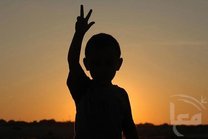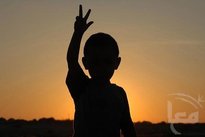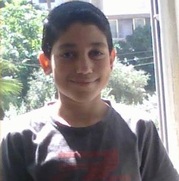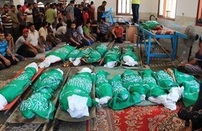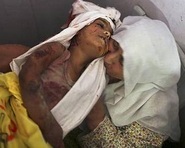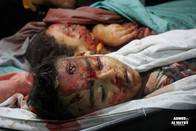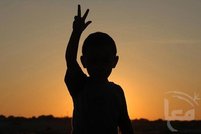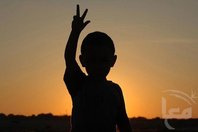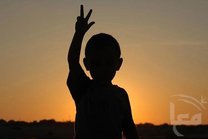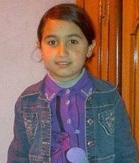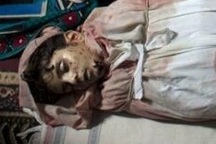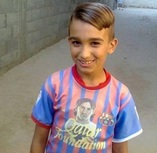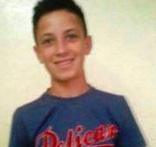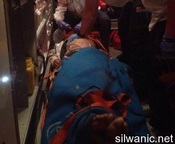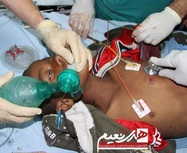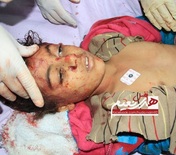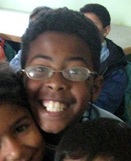OPERATION PROTECTIVE EDGE 8 JULY-26 AUG 2014
OPERATION PILLAR OF CLOUD 14-21 NOV 2012
OPERATION PILLAR OF CLOUD 14-21 NOV 2012
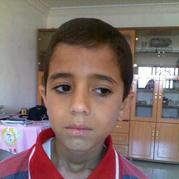
Hameed Younis Abu Doqqa 13
Killed 8 nov 2012
Palestinian boy was fatally shot on Thursday by Israeli helicopter gunfire during incursion by the occupation forces in the southern Gaza Strip.
Local and medical sources told PIC's reporter that the thirteen-year-old Hmeid Yunes Abu Daqqa died after being shot during an incursion by the occupation forces in Abasan, east of Khan Yunis.
The child was shot by a live bullet in the abdomen while he was standing in front of his house, when Israeli helicopters and tanks opened intensive fire towards the Farrahin neighborhood in Abasan, in order to cover their withdrawal from the area, the sources added.
The shooting happened around noon and the Palestinian teenager died in hospital, the Gaza Health ministry spokesman said.
Israeli military vehicles briefly penetrated the southern Gaza Strip earlier Thursday morning, leading to clashes with Palestinian resistance.
The Popular Resistance Committees said its fighters had confronted an Israeli force of four tanks and a bulldozer involved in a short-range incursion beyond border fence.
Palestinian fighters said they detonated an Israeli military vehicle near Khuzaa, east of Khan Younis.
Killed 8 nov 2012
Palestinian boy was fatally shot on Thursday by Israeli helicopter gunfire during incursion by the occupation forces in the southern Gaza Strip.
Local and medical sources told PIC's reporter that the thirteen-year-old Hmeid Yunes Abu Daqqa died after being shot during an incursion by the occupation forces in Abasan, east of Khan Yunis.
The child was shot by a live bullet in the abdomen while he was standing in front of his house, when Israeli helicopters and tanks opened intensive fire towards the Farrahin neighborhood in Abasan, in order to cover their withdrawal from the area, the sources added.
The shooting happened around noon and the Palestinian teenager died in hospital, the Gaza Health ministry spokesman said.
Israeli military vehicles briefly penetrated the southern Gaza Strip earlier Thursday morning, leading to clashes with Palestinian resistance.
The Popular Resistance Committees said its fighters had confronted an Israeli force of four tanks and a bulldozer involved in a short-range incursion beyond border fence.
Palestinian fighters said they detonated an Israeli military vehicle near Khuzaa, east of Khan Younis.
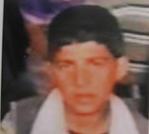
Haitham Marouf 13
Killed 29 aug 2011
died on Monday after being seriously injured in an Israeli airstrike on Beit Lahiya 10 days earlier, medics said.
Haitham Marouf, 13, died in the intensive care unit of Ash-Shifa hospital in Gaza City, medical officials said.
Shortly after midnight on Aug. 19, Israeli warplanes launched a series of raids targeting Gaza City, the northern towns of Beit Hanoun and Beit Lahiya, and Khan Younis in the south.
The raids followed a shooting attack in Eilat in which eight Israelis were killed. Israel blamed a Gaza-based militant group the Popular Resistance Committee and bombarded the Gaza Strip killing 13 people and injuring dozens more over four days.
Haitham was injured in an Israeli air strike as he worked on his family’s allotment with his mother. Haitham died from his injuries on 29 August.
Haitham lived in Beit Lahiya, northern Gaza, with his parents and seven siblings. The family rents an allotment where they grow vegetables to sell in the market. Haitham’s father has been unemployed since the beginning of the Israeli blockade of Gaza in 2007, and this is their only source of income.
At around 11:15 am on Sunday, 21 August 2011, Haitham and his mother were watering vegetables in the allotment. Suddenly, his mother noticed two young men, about 50 metres away. ‘Just then,’ she recalls, ‘two home-made rockets were fired from where they were standing [...] It was a loud and terrifying noise so Haitham and I ran to our neighbour’s land. In the meantime, I heard a drone plane circling overhead; it was very loud. We stayed on the neighbour’s land for about five to seven minutes but nothing happened, so we went back to our land.’ Mother and son continued working until ‘around 11:30 am,’ Haitham’s mother remembers, ‘I suddenly felt something flying over my head very fast and then there was an explosion behind me. I was so terrified and confused I couldn’t do anything except turn around to see where the explosion had been. It was very close. I saw black and white smoke rising from where Haitham had been working.’ As the smoke cleared, she saw Haitham lying on the ground. ‘“Haitham, Haitham,” I shouted, running towards him. He was moaning in a weak voice. His left leg was twisted strangely. His right leg was twisted as well, but not as much as the left one. A large part of the flesh of his left thigh was hanging off.” Haitham’s mother shouted for help and a neighbour came and drove Haitham to the hospital. ‘I was absolutely terrified and confused at the time,’ Haitham’s mother remembers.
Haitham was admitted to the intensive care unit of Shifa Hospital in Gaza City. As his injuries were so serious, he was transferred to an Israeli hospital four days later. His father went with him. On 29 August 2011, the last day of Ramadan, Haitham’s father called to say that Haitham had died due to blood poisoning from his injuries. His mother was grief stricken: ‘I couldn’t believe it. I loved Haitham very much.’ Haitham was brought home to be buried later that day. ‘The following morning was the first day of Eid al Fitr,’ his mother recalls, ‘I woke up but I didn’t see Haitham. He didn’t say “Many happy returns of the day, mother.” He didn’t ask for money. It was very painful for me and his siblings. They can’t stop crying.’
DCI-Palestine has documented the death of three children as a result of the August air strikes in Gaza, two of whom, Islam and Malek, were under two years old.
Killed 29 aug 2011
died on Monday after being seriously injured in an Israeli airstrike on Beit Lahiya 10 days earlier, medics said.
Haitham Marouf, 13, died in the intensive care unit of Ash-Shifa hospital in Gaza City, medical officials said.
Shortly after midnight on Aug. 19, Israeli warplanes launched a series of raids targeting Gaza City, the northern towns of Beit Hanoun and Beit Lahiya, and Khan Younis in the south.
The raids followed a shooting attack in Eilat in which eight Israelis were killed. Israel blamed a Gaza-based militant group the Popular Resistance Committee and bombarded the Gaza Strip killing 13 people and injuring dozens more over four days.
Haitham was injured in an Israeli air strike as he worked on his family’s allotment with his mother. Haitham died from his injuries on 29 August.
Haitham lived in Beit Lahiya, northern Gaza, with his parents and seven siblings. The family rents an allotment where they grow vegetables to sell in the market. Haitham’s father has been unemployed since the beginning of the Israeli blockade of Gaza in 2007, and this is their only source of income.
At around 11:15 am on Sunday, 21 August 2011, Haitham and his mother were watering vegetables in the allotment. Suddenly, his mother noticed two young men, about 50 metres away. ‘Just then,’ she recalls, ‘two home-made rockets were fired from where they were standing [...] It was a loud and terrifying noise so Haitham and I ran to our neighbour’s land. In the meantime, I heard a drone plane circling overhead; it was very loud. We stayed on the neighbour’s land for about five to seven minutes but nothing happened, so we went back to our land.’ Mother and son continued working until ‘around 11:30 am,’ Haitham’s mother remembers, ‘I suddenly felt something flying over my head very fast and then there was an explosion behind me. I was so terrified and confused I couldn’t do anything except turn around to see where the explosion had been. It was very close. I saw black and white smoke rising from where Haitham had been working.’ As the smoke cleared, she saw Haitham lying on the ground. ‘“Haitham, Haitham,” I shouted, running towards him. He was moaning in a weak voice. His left leg was twisted strangely. His right leg was twisted as well, but not as much as the left one. A large part of the flesh of his left thigh was hanging off.” Haitham’s mother shouted for help and a neighbour came and drove Haitham to the hospital. ‘I was absolutely terrified and confused at the time,’ Haitham’s mother remembers.
Haitham was admitted to the intensive care unit of Shifa Hospital in Gaza City. As his injuries were so serious, he was transferred to an Israeli hospital four days later. His father went with him. On 29 August 2011, the last day of Ramadan, Haitham’s father called to say that Haitham had died due to blood poisoning from his injuries. His mother was grief stricken: ‘I couldn’t believe it. I loved Haitham very much.’ Haitham was brought home to be buried later that day. ‘The following morning was the first day of Eid al Fitr,’ his mother recalls, ‘I woke up but I didn’t see Haitham. He didn’t say “Many happy returns of the day, mother.” He didn’t ask for money. It was very painful for me and his siblings. They can’t stop crying.’
DCI-Palestine has documented the death of three children as a result of the August air strikes in Gaza, two of whom, Islam and Malek, were under two years old.
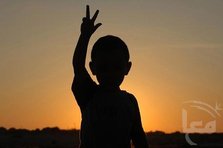
Anhar Sandouk 13
Killed 9 aug 2011
Witnesses: Ambulance held at checkpoint after fatal crash
Israeli forces delayed an ambulance treating victims of a car crash in which a 13-year-old girl died, witnesses told Ma'an.
Anhar Sandouk 13 died at the scene of an accident near Zatara checkpoint south of Nablus in the northern West Bank, medics said.
Four others, including Anhar's parents, were injured in the crash.
Witnesses told Ma'an that Israeli forces held the Palestinian ambulance at Zatara checkpoint for 30 minutes.
The girl's body was eventually taken to the Rafedia Hospital west of Nablus.
An Israeli military spokesman said he would look into the incident.
The family, from Tulkarem, was traveling to an Iftar celebration, the traditional evening meal to break the daytime fast during the Muslim holy month of Ramadan.
Killed 9 aug 2011
Witnesses: Ambulance held at checkpoint after fatal crash
Israeli forces delayed an ambulance treating victims of a car crash in which a 13-year-old girl died, witnesses told Ma'an.
Anhar Sandouk 13 died at the scene of an accident near Zatara checkpoint south of Nablus in the northern West Bank, medics said.
Four others, including Anhar's parents, were injured in the crash.
Witnesses told Ma'an that Israeli forces held the Palestinian ambulance at Zatara checkpoint for 30 minutes.
The girl's body was eventually taken to the Rafedia Hospital west of Nablus.
An Israeli military spokesman said he would look into the incident.
The family, from Tulkarem, was traveling to an Iftar celebration, the traditional evening meal to break the daytime fast during the Muslim holy month of Ramadan.

Basel Adwan 13
Killed 27 jan 2011 Cast Lead
Medics: Gaza ordnance explodes, killing child
Ordnance left behind in Israel's war on Gaza exploded Wednesday and killed a Palestinian child, medics said.
Basel died after the weaponry detonated near the Sofa crossing in the southern Gaza Strip, medical officials said.
Killed 27 jan 2011 Cast Lead
Medics: Gaza ordnance explodes, killing child
Ordnance left behind in Israel's war on Gaza exploded Wednesday and killed a Palestinian child, medics said.
Basel died after the weaponry detonated near the Sofa crossing in the southern Gaza Strip, medical officials said.
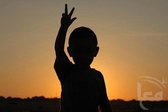
Tamer Al Sakanni 13
Killed 21 oct 2009
Tamer died in Gaza due to the siege, he was announced dead on Tuesday as he was prevented from leaving the Gaza Strip to get life saving medical care he needed.
He was suffering from cancer and needed urgent care outside Gaza but the Israeli military refused to grant the boy permission.
The Palestinian Health Ministry in Gaza announced that with Tamer's death the total number of patients who died because of the Israeli siege on Gaza since June of 2006 have reached 360.
Killed 21 oct 2009
Tamer died in Gaza due to the siege, he was announced dead on Tuesday as he was prevented from leaving the Gaza Strip to get life saving medical care he needed.
He was suffering from cancer and needed urgent care outside Gaza but the Israeli military refused to grant the boy permission.
The Palestinian Health Ministry in Gaza announced that with Tamer's death the total number of patients who died because of the Israeli siege on Gaza since June of 2006 have reached 360.
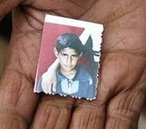
Hammad Silmiyah 13
Killed 14 feb 2009 truce violation
On 14 February 2009, almost a month after Israel declared a unilateral ceasefire in Gaza, 13-year-old Hammad Silmiya was grazing his sheep and goats in northeast Gaza, about 500 meters from the border with Israel. An Israeli military jeep patrolling the border opened fire on him and his teenage friends. Hammad was shot in the head and he died almost instantly.
Hammad’s death barely made the news — just another casualty in the Gaza Strip, where civilian injuries and deaths continue to mount daily. His family had already endured the killing of Hammad’s grandmother, his two cousins, aged four and 18 months, and the destruction of their homes and livestock during Israel’s offensive.
“It was Saturday morning and Hammad woke up at six,” says Hammad’s aunt Jomaia, 40. “He left with his brother and a couple of young friends to graze the animals. At around ten in the morning Hammad was preparing some breakfast in the field like he always did. An Israeli military vehicle fired at them and shot him in the head.”
Jomaia pulls out a plastic bag from the folds of her black shawl and unties the knot. Inside a small envelope is the only remaining photograph they have of Hammad, taken when he was seven years old. More recent photographs of him were lost in the rubble of their home.
“Hammad was like a beloved son to me because I have no children of my own and he always slept beside me,” says Jomaia. “Whenever he needed anything, he would ask me. They used to say Hammad didn’t have just one mother, he had two — his real mother, and I. Hammad owned a part of my heart and it went with him when he died.”
Hammad had left school just a few months ago to work full-time as a shepherd and help his family. “I tried to force him to go back to school but all he cared about was working with the goats and riding his donkey,” says Jomaia. “He was so good with animals. Whenever he came home from school, he’d throw his bag in the house and run to be with the animals. The night before Hammad was killed I dreamt about a wedding ceremony, which in our culture is a bad omen. When they told me Hammad was injured I knew that he had been killed because I had seen him as a bridegroom in my dream.”
Hammad’s mother Salma sits beside Jomaia in the makeshift shelter the family has set up beside the remains of their homes in Hay al-Salama, northeastern Gaza. All around them are scenes of utter devastation. This Bedouin family came to Gaza as refugees from Beersheva (then called Bir al-Saba) in 1948 and settled in the Hay al-Salama area. Prior to the latest Israeli offensive they had concrete homes and livestock farms beside the buffer zone, which was the first area to be hit during Israel’s ground offensive in January 2009.
“Tanks began firing at the area at two in the morning on the 5 of January,” recalls Jomaia. “The first bomb hit our house and I ran to my mother’s room because she is 80 years old and bedridden. Then a second shell hit the house and we had to run, leaving her behind. We were like scared goats whose stable door had been opened. We fled to Jabaliya and then to Zeitoun where we sheltered in schools. Every day I begged ambulances and medics to help me go and evacuate my mother. I even said I would walk in front of the ambulance, carrying a white flag, but it was too dangerous and they refused.”
When the Silmiya family returned to the area on 18 January, they found their row of houses had been flattened by F-16 air strikes and it took them three days to uncover Hammad’s grandmother from the rubble. Hammad was buried next to his grandmother just a few weeks later.
Due to this area’s proximity to the border, few donors have come to assess the damage or provide assistance. The nearest refugee tent camp is unsuitable for the Silmiyas because they need to be near their animals and Bedouin families prefer to live alone.
“The war is not over,” says Hammad’s mother Salma. “There is no quiet time in Gaza and we often see F-16s in the sky. But Hammad was never afraid. He was strong and full of energy. His younger brother says he wishes the Israelis had killed him instead because everybody loved Hammad. He also refuses to take any food or tea with him now when he goes shepherding because Hammad was making breakfast when they shot him.”
In the days before his death Hammad had been upset about his donkey that was killed during the Israeli ground invasion along with sixty goats and three cows belonging to his father Barrak Salem Salaam Silmiya, whose three surnames are all derivatives of the word “peace” in Arabic. “We want peace, but where is it? Where are human rights in Gaza?” asks 47-year-old Barrak as he shows us the animal remains still floating in the mud around the ruins of his house.
“Hammad was 13 years old. In anyone’s eyes he looked like a child, but they still shot him. He was very bright and he was great with animals. He even used to sell our milk and cheese in the market. What more can I tell the world about my son? How can I speak about him? Big countries can’t even stop Israel so what can I do? I feel like I’m nothing. This area was just houses and a street. Were these goats fighters? There’s nothing left.”
As Barrak turns to walk away Hammad’s mother Salma rises to her feet: “These 15 days since Hammad died have felt like 500. Hammad was dark, and he was beautiful. Food has no taste anymore.”
“Everybody who saw Hammad that morning before he was killed said his face had looked particularly beautiful,” adds his aunt Jomaia. “This is not a war against a strong government or country. Israel kills us like we are animals and dogs and nobody stands with us.”
This report is part of the Palestinian Centre for Human Rights series “Aftermath” that looks at the aftermath of Israel’s 22-day offensive on the Gaza Strip, and the ongoing impact it is having on the civilian population.
Killed 14 feb 2009 truce violation
On 14 February 2009, almost a month after Israel declared a unilateral ceasefire in Gaza, 13-year-old Hammad Silmiya was grazing his sheep and goats in northeast Gaza, about 500 meters from the border with Israel. An Israeli military jeep patrolling the border opened fire on him and his teenage friends. Hammad was shot in the head and he died almost instantly.
Hammad’s death barely made the news — just another casualty in the Gaza Strip, where civilian injuries and deaths continue to mount daily. His family had already endured the killing of Hammad’s grandmother, his two cousins, aged four and 18 months, and the destruction of their homes and livestock during Israel’s offensive.
“It was Saturday morning and Hammad woke up at six,” says Hammad’s aunt Jomaia, 40. “He left with his brother and a couple of young friends to graze the animals. At around ten in the morning Hammad was preparing some breakfast in the field like he always did. An Israeli military vehicle fired at them and shot him in the head.”
Jomaia pulls out a plastic bag from the folds of her black shawl and unties the knot. Inside a small envelope is the only remaining photograph they have of Hammad, taken when he was seven years old. More recent photographs of him were lost in the rubble of their home.
“Hammad was like a beloved son to me because I have no children of my own and he always slept beside me,” says Jomaia. “Whenever he needed anything, he would ask me. They used to say Hammad didn’t have just one mother, he had two — his real mother, and I. Hammad owned a part of my heart and it went with him when he died.”
Hammad had left school just a few months ago to work full-time as a shepherd and help his family. “I tried to force him to go back to school but all he cared about was working with the goats and riding his donkey,” says Jomaia. “He was so good with animals. Whenever he came home from school, he’d throw his bag in the house and run to be with the animals. The night before Hammad was killed I dreamt about a wedding ceremony, which in our culture is a bad omen. When they told me Hammad was injured I knew that he had been killed because I had seen him as a bridegroom in my dream.”
Hammad’s mother Salma sits beside Jomaia in the makeshift shelter the family has set up beside the remains of their homes in Hay al-Salama, northeastern Gaza. All around them are scenes of utter devastation. This Bedouin family came to Gaza as refugees from Beersheva (then called Bir al-Saba) in 1948 and settled in the Hay al-Salama area. Prior to the latest Israeli offensive they had concrete homes and livestock farms beside the buffer zone, which was the first area to be hit during Israel’s ground offensive in January 2009.
“Tanks began firing at the area at two in the morning on the 5 of January,” recalls Jomaia. “The first bomb hit our house and I ran to my mother’s room because she is 80 years old and bedridden. Then a second shell hit the house and we had to run, leaving her behind. We were like scared goats whose stable door had been opened. We fled to Jabaliya and then to Zeitoun where we sheltered in schools. Every day I begged ambulances and medics to help me go and evacuate my mother. I even said I would walk in front of the ambulance, carrying a white flag, but it was too dangerous and they refused.”
When the Silmiya family returned to the area on 18 January, they found their row of houses had been flattened by F-16 air strikes and it took them three days to uncover Hammad’s grandmother from the rubble. Hammad was buried next to his grandmother just a few weeks later.
Due to this area’s proximity to the border, few donors have come to assess the damage or provide assistance. The nearest refugee tent camp is unsuitable for the Silmiyas because they need to be near their animals and Bedouin families prefer to live alone.
“The war is not over,” says Hammad’s mother Salma. “There is no quiet time in Gaza and we often see F-16s in the sky. But Hammad was never afraid. He was strong and full of energy. His younger brother says he wishes the Israelis had killed him instead because everybody loved Hammad. He also refuses to take any food or tea with him now when he goes shepherding because Hammad was making breakfast when they shot him.”
In the days before his death Hammad had been upset about his donkey that was killed during the Israeli ground invasion along with sixty goats and three cows belonging to his father Barrak Salem Salaam Silmiya, whose three surnames are all derivatives of the word “peace” in Arabic. “We want peace, but where is it? Where are human rights in Gaza?” asks 47-year-old Barrak as he shows us the animal remains still floating in the mud around the ruins of his house.
“Hammad was 13 years old. In anyone’s eyes he looked like a child, but they still shot him. He was very bright and he was great with animals. He even used to sell our milk and cheese in the market. What more can I tell the world about my son? How can I speak about him? Big countries can’t even stop Israel so what can I do? I feel like I’m nothing. This area was just houses and a street. Were these goats fighters? There’s nothing left.”
As Barrak turns to walk away Hammad’s mother Salma rises to her feet: “These 15 days since Hammad died have felt like 500. Hammad was dark, and he was beautiful. Food has no taste anymore.”
“Everybody who saw Hammad that morning before he was killed said his face had looked particularly beautiful,” adds his aunt Jomaia. “This is not a war against a strong government or country. Israel kills us like we are animals and dogs and nobody stands with us.”
This report is part of the Palestinian Centre for Human Rights series “Aftermath” that looks at the aftermath of Israel’s 22-day offensive on the Gaza Strip, and the ongoing impact it is having on the civilian population.
